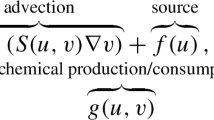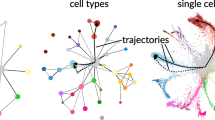Abstract
Scratch assays are used to study how a population of cells re-colonises a vacant region on a two-dimensional substrate after a cell monolayer is scratched. These experiments are used in many applications including drug design for the treatment of cancer and chronic wounds. To provide insights into the mechanisms that drive scratch assays, solutions of continuum reaction–diffusion models have been calibrated to data from scratch assays. These models typically include a logistic source term to describe carrying capacity-limited proliferation; however, the choice of using a logistic source term is often made without examining whether it is valid. Here we study the proliferation of PC-3 prostate cancer cells in a scratch assay. All experimental results for the scratch assay are compared with equivalent results from a proliferation assay where the cell monolayer is not scratched. Visual inspection of the time evolution of the cell density away from the location of the scratch reveals a series of sigmoid curves that could be naively calibrated to the solution of the logistic growth model. However, careful analysis of the per capita growth rate as a function of density reveals several key differences between the proliferation of cells in scratch and proliferation assays. Our findings suggest that the logistic growth model is valid for the entire duration of the proliferation assay. On the other hand, guided by data, we suggest that there are two phases of proliferation in a scratch assay; at short time, we have a disturbance phase where proliferation is not logistic, and this is followed by a growth phase where proliferation appears to be logistic. These two phases are observed across a large number of experiments performed at different initial cell densities. Overall our study shows that simply calibrating the solution of a continuum model to a scratch assay might produce misleading parameter estimates, and this issue can be resolved by making a distinction between the disturbance and growth phases. Repeating our procedure for other scratch assays will provide insight into the roles of the disturbance and growth phases for different cell lines and scratch assays performed on different substrates.









Similar content being viewed by others
References
Adobe Systems Incorporated (2016) Count objects in an image. http://helpx.adobe.com/photoshop/using/counting-objects-image.html
Alarcón T, Byrne HM, Maini PK (2003) A cellular automaton model for tumour growth in inhomogeneous environment. J Theor Biol 225:257–274
Allee WC, Bowen ES (1932) Studies in animal aggregations: mass protection against colloidal silver among goldfishes. J Exp Zool A Ecol Genet Physiol 61:185–207
Cai AQ, Landman KA, Hughes BD (2007) Multi-scale modeling of a wound-healing cell migration assay. J Theor Biol 245:576–594
Chan MH, Kim PS (2013) Modelling a Wolbachia invasion using a slow–fast dispersal reaction–diffusion approach. Bull Math Biol 75:1501–1523
Chapra SC, Canale RP (2010) Numerical methods for engineers, 6th edn. McGraw-Hill, Boston
Dennis B, Taper ML (1994) Density dependence in time series observations of natural populations: estimation and testing. Ecol Monogr 64:205–224
Jin W, Shah ET, Penington CJ, McCue SW, Chopin LK, Simpson MJ (2016) Reproducibility of scratch assays is affected by the initial degree of confluence: experiments, modelling and model selection. J Theor Biol 390:136–145
Johnston ST, Shah ET, Chopin LK, McElwain DLS, Simpson MJ (2015) Estimating cell diffusivity and cell proliferation rate by interpreting IncuCyte ZOOM\(^{\rm {TM}}\) assay data using the Fisher–Kolmogorov model. BMC Syst Biol 9:38
Johnston ST, Baker RE, McElwain DLS, Simpson MJ (2017) Co-operation, competition and crowding: a discrete framework linking Allee kinetics, nonlinear diffusion, shocks and sharp-fronted travelling waves. Sci Rep 7:42134
Jones LJ, Gray M, Yue ST, Haugland RP, Singer VL (2001) Sensitive determination of cell number using the CyQUANT\(^{\textregistered }\) cell proliferation assay. J Immunol Methods 254:85–98
Kaighn ME, Narayan KS, Ohnuki Y, Lechner JF, Jones LW (1979) Establishment and characterization of a human prostatic carcinoma cell line (PC-3). Invest Urol 17:16–23
Kramer N, Walzl A, Unger C, Rosner M, Krupitza G, Hengstschläger M et al (2013) In vitro cell migration and invasion assays. Mutat Res Rev Mutat Res 752:10–24
Laird AK (1964) Dynamics of tumor growth. Br J Cancer 18:490–502
Lewis MA, Kareiva P (1993) Allee dynamics and the spread of invading organisms. Theor Popul Biol 43:141–158
Liang CC, Park AY, Guan JL (2007) In vitro scratch assay: a convenient and inexpensive method for analysis of cell migration in vitro. Nat Protoc 2:329–333
Louis KS, Siegel AC (2011) Cell viability analysis using trypan blue: manual and automated methods. In: Stoddart JM (ed) Mammalian cell viability: methods and protocols. Humana Press, Totowa, pp 7–12
Maini PK, McElwain DLS, Leavesley DI (2004a) Traveling wave model to interpret a wound-healing cell migration assay for human peritoneal mesothelial cells. Tissue Eng 10:475–482
Maini PK, McElwain DLS, Leavesley D (2004b) Travelling waves in a wound healing assay. Appl Math Lett 17:575–580
Mallet DG, De Pillis LG (2006) A cellular automata model of tumor–immune system interactions. J Theor Biol 239:334–350
MathWorks. (2016) Solve nonlinear curve-fitting (data-fitting) problems in least-squares sense. MathWorks. http://au.mathworks.com/help/optim/ug/lsqcurvefit.html
Murray JD (2002) Mathematical biology. I: An introduction, 3rd edn. Springer, Heidelberg
Nikolić DL, Boettiger AN, Bar-Sagi D, Carbeck JD, Shvartsman SY (2006) Role of boundary conditions in an experimental model of epithelial wound healing. Am J Physiol Cell Physiol 291:C68–C75
Nishio T, Kawaguchi S, Yamamoto M, Iseda T, Kawasaki T, Hase T (2005) Tenascin-C regulates proliferation and migration of cultured astrocytes in a scratch wound assay. Neuroscience 132:87–102
Ribba B, Colin T, Schnell S (2006) A multiscale mathematical model of cancer, and its use in analyzing irradiation therapies. Theor Biol Med Model 3:7
Roques L, Garnier J, Hamel F, Klein EK (2012) Allee effect promotes diversity in traveling waves of colonization. Proc Natl Acad Sci USA 109:8828–8833
Sarapata EA, de Pillis LG (2014) A comparison and catalog of intrinsic tumor growth models. Bull Math Biol 76:2010–2024
Savla U, Olson LE, Waters CM (2004) Mathematical modeling of airway epithelial wound closure during cyclic mechanical strain. J Appl Physiol 96:566–574
Sengers BG, Please CP, Oreffo RO (2007) Experimental characterization and computational modelling of two-dimensional cell spreading for skeletal regeneration. J R Soc Interface 4:1107–1117
Sewalt L, Harley K, van Heijster P, Balasuriya S (2016) Influences of Allee effects in the spreading of malignant tumours. J Theor Biol 394:77–92
Shakeel M, Matthews PC, Graham RS, Waters SL (2013) A continuum model of cell proliferation and nutrient transport in a perfusion bioreactor. Math Med Biol 30:21–44
Sheardown H, Cheng YL (1996) Mechanisms of corneal epithelial wound healing. Chem Eng Sci 51:4517–4529
Simpson MJ, Landman KA, Bhaganagarapu K (2007) Coalescence of interacting cell populations. J Theor Biol 247:525–543
Simpson MJ, Binder BJ, Haridas P, Wood BK, Treloar KK, McElwain DLS et al (2013) Experimental and modelling investigation of monolayer development with clustering. Bull Math Biol 75:871–889
Simpson MJ, Sharp JA, Baker RE (2014) Distinguishing between mean-field, moment dynamics and stochastic descriptions of birth–death–movement processes. Phys A 395:236–246
Taylor CM, Hastings A (2005) Allee effects in biological invasions. Ecol Lett 8:895–908
Treloar KK, Simpson MJ (2013) Sensitivity of edge detection methods for quantifying cell migration assays. PLoS ONE 8:e67389
Tremel A, Cai A, Tirtaatmadja N, Hughes BD, Stevens GW, Landman KA et al (2009) Cell migration and proliferation during monolayer formation and wound healing. Chem Eng Sci 64:247–253
Vo BN, Drovandi CC, Pettitt AN, Simpson MJ (2015) Quantifying uncertainty in parameter estimates for stochastic models of collective cell spreading using approximate Bayesian computation. Math Biosci 263:133–142
Waters EK, Sidhu HS, Sidhu LA, Mercer GN (2015) Extended Lotka–Volterra equations incorporating population heterogeneity: derivation and analysis of the predator–prey case. Ecol Model 297:187–195
West GB, Brown JH, Enquist BJ (2001) A general model for ontogenetic growth. Nature 413:628–631
Zwietering MH, Jongenburger I, Rombouts FM, Van’t Riet K (1990) Modeling of the bacterial growth curve. Appl Environ Microbiol 56:1875–1881
Acknowledgements
This work is supported by the Australian Research Council (DP140100249, FT130100148), and we appreciate the helpful comments from the two referees.
Author information
Authors and Affiliations
Corresponding author
Electronic supplementary material
Below is the link to the electronic supplementary material.
Rights and permissions
About this article
Cite this article
Jin, W., Shah, E.T., Penington, C.J. et al. Logistic Proliferation of Cells in Scratch Assays is Delayed. Bull Math Biol 79, 1028–1050 (2017). https://doi.org/10.1007/s11538-017-0267-4
Received:
Accepted:
Published:
Issue Date:
DOI: https://doi.org/10.1007/s11538-017-0267-4




